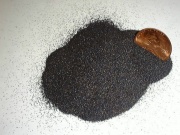Difference between revisions of "Titanium"
(username removed) |
|||
| (4 intermediate revisions by 3 users not shown) | |||
| Line 2: | Line 2: | ||
== Description == | == Description == | ||
| − | A dark gray shiny metallic element. Titanium was identified by William Gregor in 1791 and separated in 1825 by Baron Berzelius. It has an abundance of 0.63% and occurs primarily in [ | + | A dark gray shiny metallic element. Titanium was identified by William Gregor in 1791 and separated in 1825 by Baron Berzelius. It has an abundance of 0.63% and occurs primarily in [[rutile]], [[anatase]], [[sphene]], [[titanite]], [[ilmenite]], perovskite, or brookite minerals. Titanium is strong but lightweight. It is used as a metal alloy with [[copper], [[iron]], and [[steel]], to add strength while decreasing mass. Titanium alloys are used in aircraft, missiles, and space capsules. The Mercury, Gemini, and Apollo capsules were mostly made of titanium. Titanium compounds are used as [[abrasive|abrasives]] and [[pigment|pigments]]. Synthetically produced zinc antimony titanate was considered the best ceramic opacifier in the early 20th c. |
[[File:Titaniummetalemr2.jpg|thumb|Metallic titanium, powdered]] | [[File:Titaniummetalemr2.jpg|thumb|Metallic titanium, powdered]] | ||
| + | |||
== Synonyms and Related Terms == | == Synonyms and Related Terms == | ||
| − | Ti; Titaan (Ned.); titane (Fr.); Titan (Deut.; Sven.); titanio (It., Esp.); | + | Ti; Titaan (Ned.); titane (Fr.); Titan (Deut.; Sven.); titanio (It., Esp.); Titânio (Port.); titania |
== Other Properties == | == Other Properties == | ||
| Line 47: | Line 48: | ||
Web Elements: [http://www.webelements.com/webelements/elements/text/Ti/key.html Website] | Web Elements: [http://www.webelements.com/webelements/elements/text/Ti/key.html Website] | ||
| − | == | + | == Sources Checked for Data in Record == |
| − | * | + | * Cricket Harbeck, Adhesives Commonly used in Objects Conservation, unpublished, 1996 Comment: "Ceramic Pigments' Industrial and Engineering Chemistry 30(7), 1938. |
| − | * | + | * External source or communication Comment: C. J. Harbeck, 'Ceramic Pigments' ''Industrial and Engineering Chemistry'', 30(7), 1938. |
| − | * | + | * G.S.Brady, ''Materials Handbook'', McGraw-Hill Book Co., New York, 1971 Comment: p. 811 |
| − | * | + | * Richard S. Lewis, ''Hawley's Condensed Chemical Dictionary'', Van Nostrand Reinhold, New York, 10th ed., 1993 |
* ''Van Nostrand's Scientific Encyclopedia'', Douglas M. Considine (ed.), Van Nostrand Reinhold, New York, 1976 | * ''Van Nostrand's Scientific Encyclopedia'', Douglas M. Considine (ed.), Van Nostrand Reinhold, New York, 1976 | ||
| − | * | + | * Random House, ''Webster's Encyclopedic Unabridged Dictionary of the English Language'', Grammercy Book, New York, 1997 |
* ''The Merck Index'', Martha Windholz (ed.), Merck Research Labs, Rahway NJ, 10th edition, 1983 Comment: entry 9610 | * ''The Merck Index'', Martha Windholz (ed.), Merck Research Labs, Rahway NJ, 10th edition, 1983 Comment: entry 9610 | ||
| Line 65: | Line 66: | ||
* ''The American Heritage Dictionary'' or ''Encarta'', via Microsoft Bookshelf 98, Microsoft Corp., 1998 Comment: first isolated by Baron Berzelius in 1823 | * ''The American Heritage Dictionary'' or ''Encarta'', via Microsoft Bookshelf 98, Microsoft Corp., 1998 Comment: first isolated by Baron Berzelius in 1823 | ||
| − | * | + | * Website address 1 Comment: web Elements at http://www.webelements.com/webelements/elements/text/Ti/hist.html :first isolated in 1910 by Matthew Hunter |
[[Category:Materials database]] | [[Category:Materials database]] | ||
Revision as of 13:25, 30 May 2020
Description
A dark gray shiny metallic element. Titanium was identified by William Gregor in 1791 and separated in 1825 by Baron Berzelius. It has an abundance of 0.63% and occurs primarily in Rutile, Anatase, Sphene, Titanite, Ilmenite, perovskite, or brookite minerals. Titanium is strong but lightweight. It is used as a metal alloy with [[copper], Iron, and Steel, to add strength while decreasing mass. Titanium alloys are used in aircraft, missiles, and space capsules. The Mercury, Gemini, and Apollo capsules were mostly made of titanium. Titanium compounds are used as abrasives and pigments. Synthetically produced zinc antimony titanate was considered the best ceramic opacifier in the early 20th c.
Synonyms and Related Terms
Ti; Titaan (Ned.); titane (Fr.); Titan (Deut.; Sven.); titanio (It., Esp.); Titânio (Port.); titania
Other Properties
Soluble in hot concentrated sulfuric and hydrochloric acid. Insoluble in water. Corrosion resistance to chlorine, seawater, air pollution, alkalis.
| Composition | Ti (atomic no. 22) |
|---|---|
| CAS | 7440-32-6 |
| Melting Point | 1670-1677 |
| Density | 4.6 |
| Molecular Weight | atomic wt = 47.867 |
| Refractive Index | 2.5-2.9 |
| Boiling Point | 3260-3280 |
Hazards and Safety
Powder is flammable. Fire and explosion risk.
Fisher Scientific: MSDS
Additional Information
Web Elements: Website
Sources Checked for Data in Record
- Cricket Harbeck, Adhesives Commonly used in Objects Conservation, unpublished, 1996 Comment: "Ceramic Pigments' Industrial and Engineering Chemistry 30(7), 1938.
- External source or communication Comment: C. J. Harbeck, 'Ceramic Pigments' Industrial and Engineering Chemistry, 30(7), 1938.
- G.S.Brady, Materials Handbook, McGraw-Hill Book Co., New York, 1971 Comment: p. 811
- Richard S. Lewis, Hawley's Condensed Chemical Dictionary, Van Nostrand Reinhold, New York, 10th ed., 1993
- Van Nostrand's Scientific Encyclopedia, Douglas M. Considine (ed.), Van Nostrand Reinhold, New York, 1976
- Random House, Webster's Encyclopedic Unabridged Dictionary of the English Language, Grammercy Book, New York, 1997
- The Merck Index, Martha Windholz (ed.), Merck Research Labs, Rahway NJ, 10th edition, 1983 Comment: entry 9610
- The American Heritage Dictionary or Encarta, via Microsoft Bookshelf 98, Microsoft Corp., 1998 Comment: first isolated by Baron Berzelius in 1823
- Website address 1 Comment: web Elements at http://www.webelements.com/webelements/elements/text/Ti/hist.html :first isolated in 1910 by Matthew Hunter

